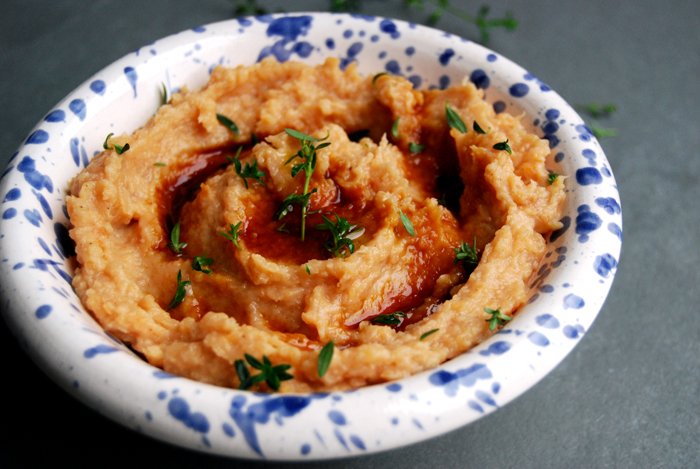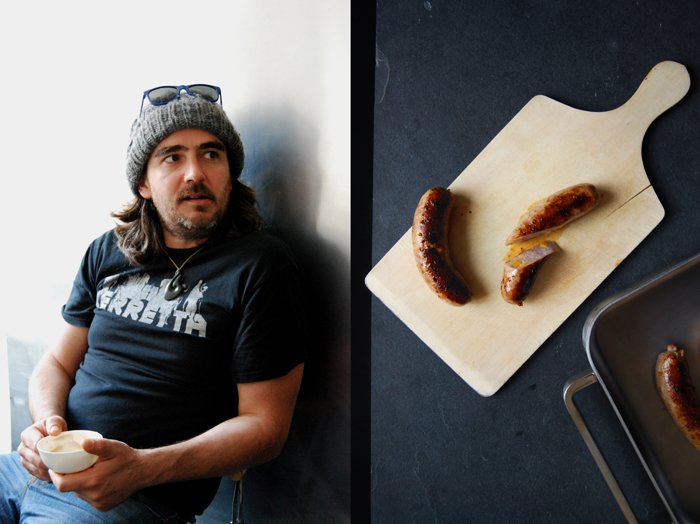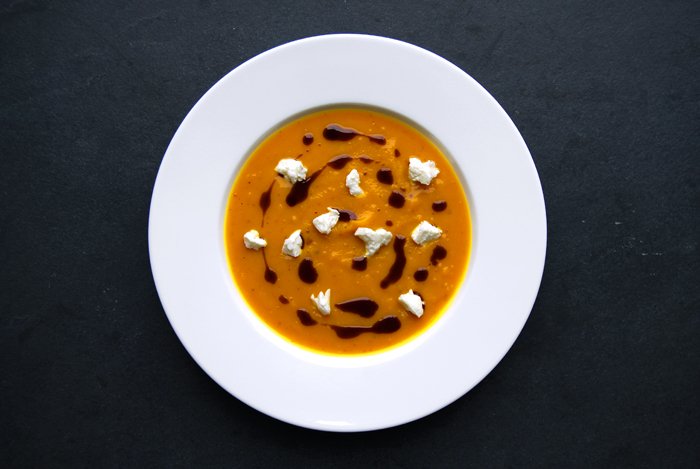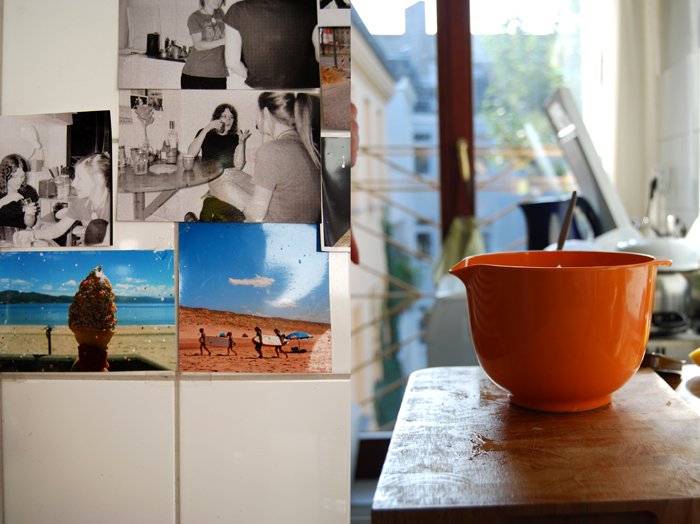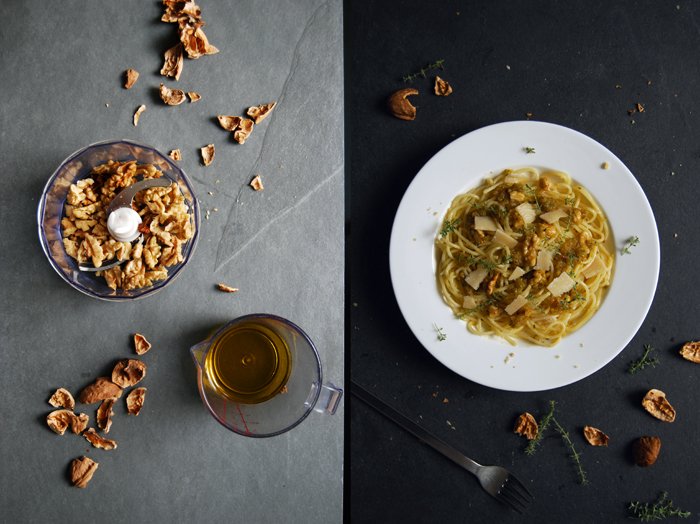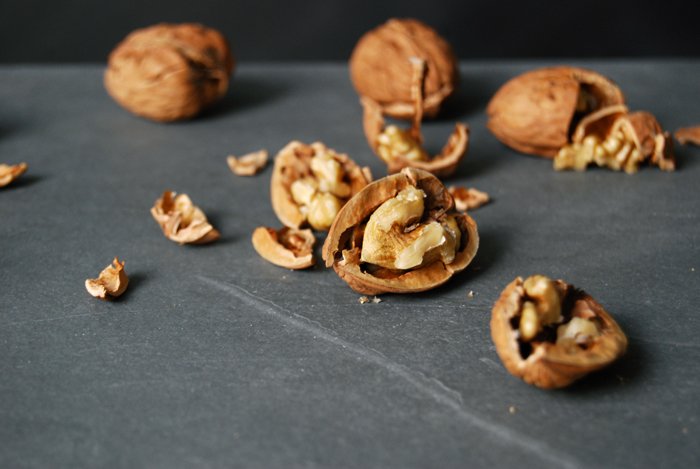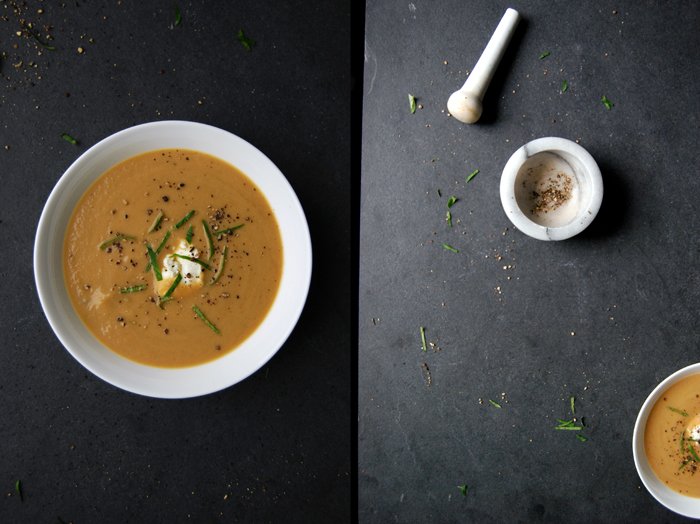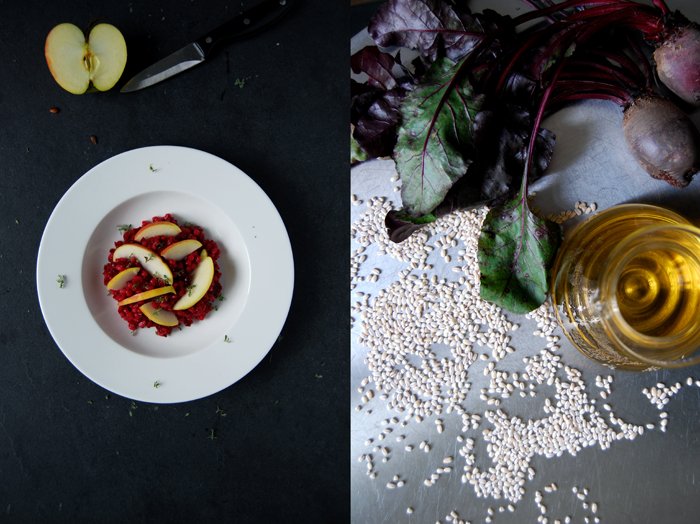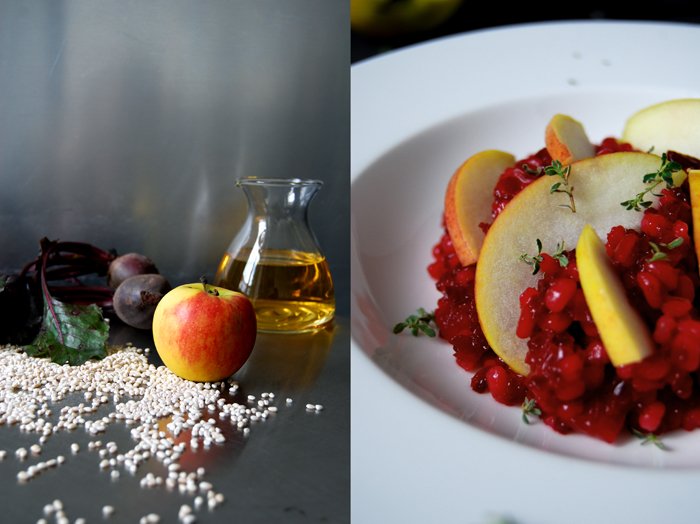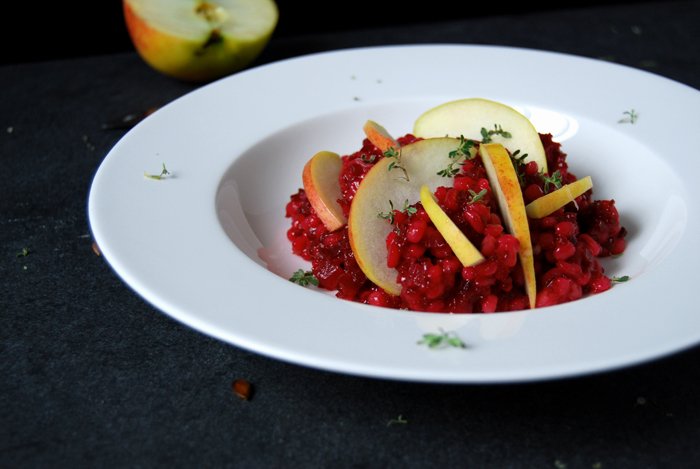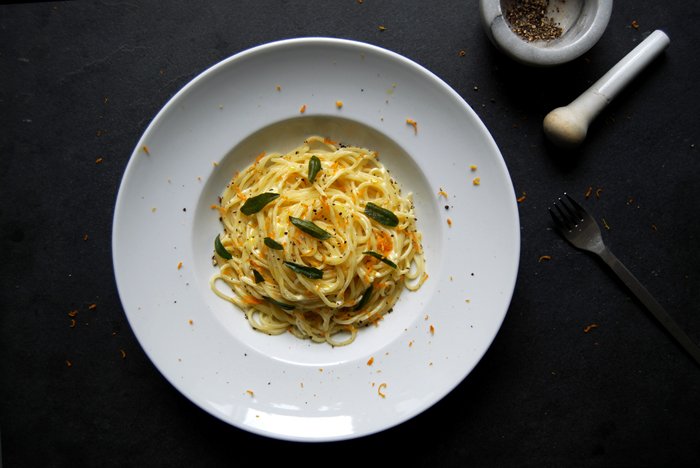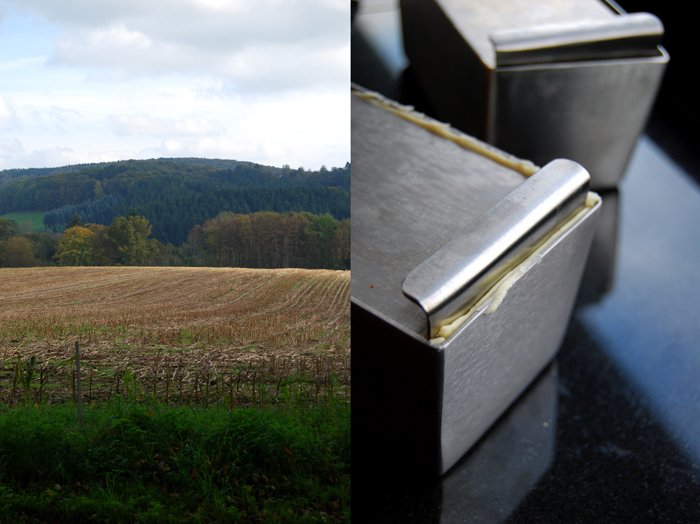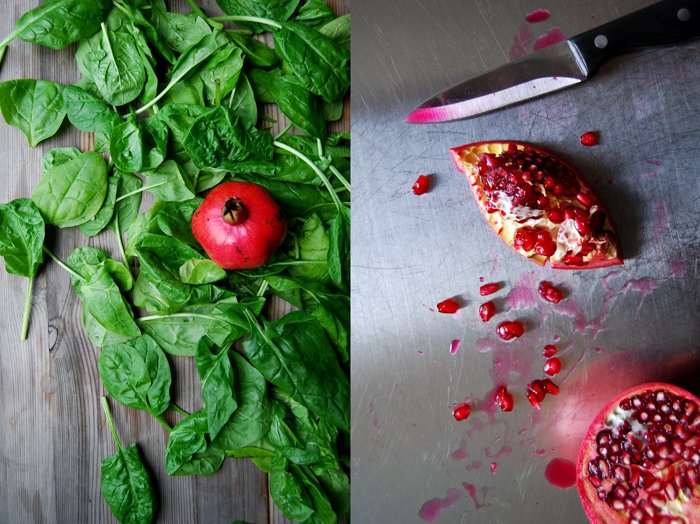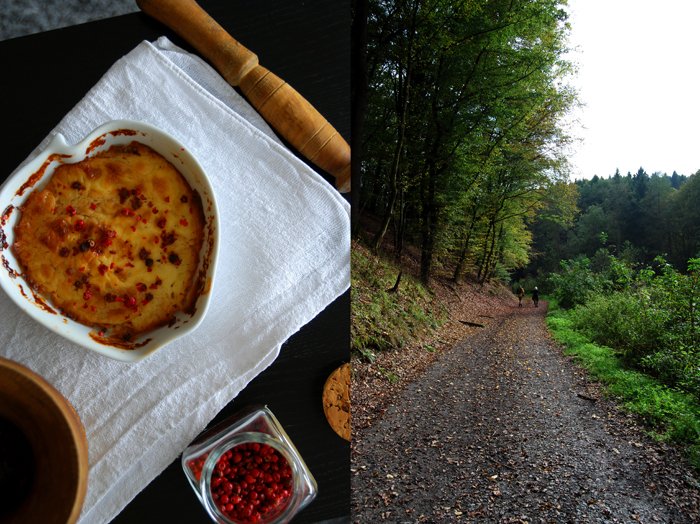Quince and Rutabaga Purée with Apple Balsamico and Thyme
What can be done with leftover quince and rutabaga? Throw them together and mash them with sweet Apple Balsamico vinegar and thyme! When I made my ginger lemon brandy with quince last week I bought too many of the fruits (as always) and their colour slowly changed from yellow to brown in the past few days. It was time to use them before they looked like potatoes. I could have also made jelly out of them but I still have a couple jars left, I just use it to refine sauces but it never finds its way onto my breakfast table. The competition in my pantry is tough, there's also white vineyard peach jam, Tyrolean plums and my all time favourite, chunky strawberry. Soon I'll make new batches of my tangerine and my blood orange marmalade and I'm slowly running out of space.
So no more jam but a purée which is a fruity alternative to mashed potatoes, ideally with a hearty roast and some aromatic gravy on the plate - heavenly! Both the quince and rutabaga flavours came through quite balanced and merged with the woody thyme, a little maple syrup and thick Apple Balsamico. You could use normal balsamic vinegar as well but the apple complements the quince and adds a little more sweetness, pear balsamico would be nice too. If you have it at hand, here's the perfect dish for it to show off its qualities!
Quince and Rutabaga Purée with Apple Balsamico and Thyme
As a side dish for 4 you need
rutabaga, peeled and cut into little cubes, 300g / 10.5 ounces
quince, peeled, cored and cut into little cubes, 3
white wine
granulated sugar 1 teaspoon
salt and pepper
a pinch of cinnamon
olive oil
maple syrup, 1-2 tablespoons, to taste
apple balsamic vinegar, 1-2 tablespoons, to taste
fresh thyme leaves, 1 tablespoon plus more for the topping
In a sauce pan, heat a little olive oil and sauté the quince and rutabaga with the sugar for 2-3 minutes on medium heat. Deglaze with a splash of white wine and add some water, it should come up about 2.5cm / 1". Season with salt, pepper and cinnamon and stir in the maple syrup. Close with a lid and let it simmer on medium-low heat for about 30-40 minutes or until the fruit and root are soft, purée in a blender and season to taste. Serve warm, sprinkled with thyme and a little more Balsamico vinegar.
Roasted Ginger Lemon Brussels Sprouts
The fact that I found a bag with little green Brussels sprouts at the far, far end of my fridge says a lot about my relation to this miniature cabbage. When I have them on my plate, I enjoy eating them, but if I'm not asked to cook them, they barely find their way into my pots. But this might change as I made a new discovery, roasted ginger lemon Brussels sprouts! It's amazing how the two lemony spices manage to turn the strong aroma of the green leaves into something new, less heavy and almost fresh. I was impressed! I often mix Brussels sprouts with smoky bacon to soften their dominance, the meat's saltiness is one of the few flavours that can handle this cabbage, but my new find is even better!
This dish is really easy to prepare, once you removed the outer leaves, the cabbages are completely coated in a strong ginger lemon olive oil and roasted in the oven for about half an hour. If you're a big fan of these two flavours (like me) you can add a lot of grated ginger and lemon zest to the aromatic oil to give the vegetable a completely new direction. A while ago, these two aromas worked wonders in another recipe of mine, my refreshing cauliflower soup. I also wanted to bring out the Brussels sprouts' sweet side in this recipe so I sprinkled them with a bit of sugar before I put them in the oven to caramelize them a little. The added sweetness fit perfectly!
This makes a great side dish for poultry or Sunday roasts but also a delicious vegetarian lunch, if you're still looking for some greens for your Thanksgiving table, here you go!
Roasted Ginger Lemon Brussels Sprouts
For 4 people you need
Brussels sprouts, trimmed, cut in half, 750g / 1 3/4 pounds
olive oil 50ml / 1/4 cup
freshly squeezed lemon juice 1 tablespoon
zest of 1 lemon
freshly grated ginger 1 tablespoon
sea salt
granulated sugar 1/2-1 teaspoon
Set the oven to 200°C / 390°F (I use the Rotitherm setting).
Whisk the olive oil with the lemon juice, zest and ginger. Spread the Brussels sprouts in a baking dish and mix them with the aromatic oil using your fingers to coat them thoroughly. Sprinkle them with sugar and salt. Put the baking dish in the oven and turn the cabbages with a spoon or spatula after about 10 minutes and then every 5 minutes to prevent them turning too dark. Take them out of the oven after about 25-30 minutes or when they are golden brown and al dente.
Spinach Gnocchi with creamy Mushrooms
A homemade gnocchi dinner is quite a satisfying experience on many levels. Let's start with the preparation: it takes a bit longer than cooking spaghetti but it rewards you with the feeling that you've created something special, something pretty and impressive on your plates. Here you don't cook someone else's product in hot water, this is your own dough made with fresh ingredients, gnocchi formed with love and attention. I believe that the effort you put into a meal is saved in it, you can taste it!
Making gnocchi can be intimidating but it doesn't have to be, it's about the right ratio between dry and moist ingredients, and taste obviously. When I make my potato or pumpkin gnocchi I know that I have to follow a few rules. The most important one is not to mix the flour into the vegetable mixture when it's still warm, it has to cool off completely or the gnocchi won't stay in shape. If you think that your dough is too sticky you just add a little more flour until you can hold it in your floured hands. It should feel a bit like yeast dough for pizza, when it's more like glue, impossible to get off your fingers, you have to make some more adjustments. Be brave and it'll work out!
Although my spinach gnocchi are made with fresh breadcrumbs and not potatoes, they follow the same rules. I blanche lots of crunchy winter spinach, squeeze it well and let it cool. Again, if it's too moist and still warm it can cause hassles. Once it's done, I mix it with the bread, a little flour, the spices and parmesan. The green dumplings are very easy to handle, you can even prepare them a few hours ahead before you cook them. I wanted the spinach to come through strong and earthy to keep up with my creamy sauce made of sautéed mushrooms. I also added some salty bacon bits but it's just as good without the smoky flavour, the meat gives it a hearty touch, just choose what you feel like.
When I saw the plate in front of me, a perfect picture of comfortable Italian food, I knew why I don't buy gnocchi from the store. They never taste as good, that's for sure, but they also don't have my kitchen memories saved in every little bite.
Spinach Gnocchi with creamy Mushrooms
For 3-4 people you need
For the mushrooms
mushrooms, the bottom cut off, cut into thick slices, 300g / 10.5 ounces
heavy cream 150-200ml / 5.5-7 ounces
brandy
olive oil
salt and pepper
optional: bacon, cut into small cubes, 60g / 2 ounces
In a large pan, fry the bacon in a little oil for a few minutes on medium heat until golden brown and crisp. Take the bacon out of the pan and add a little more oil if necessary, sauté the mushrooms on high temperature for 1 minute on each side. Deglaze with a splash of brandy, season with salt and pepper to taste and add the cream.
For the gnocchi
fresh spinach leaves (stems cut off), rinsed, 500g / 1 pound
breadcrumbs, freshly ground with a grater or in a food processor, 250g / 9 ounces
organic egg yolks 2
plain flour 70g / 2.5 ounces
Parmesan, freshly grated, 40g / 2 ounces plus more for the topping
salt 1 1/2 teaspoons
nutmeg
pepper
Blanche the spinach in a large pot of boiling, salted water for 1 1/2 minutes. Drain, rinse with cold water and let it cool in a colander for about 10 minutes. Squeeze the spinach in batches in between your hands but mind that it isn't hot anymore. The spinach should be quite dry. Purée the leaves in a food processor and mix with the other ingredients until well combined.
On a well floured surface, roll the dough in batches into a 2cm / 3/4" sausage shape and cut off 3cm / 1 1/4" gnocchi. Spread them on a well floured baking sheet.
In a large pot, bring salted water to the boil and cook the gnocchi in batches on medium heat (simmering). When they start to rise and float on the surface after about 4 minutes take them out with a slotted ladle and drain them for a few seconds. Keep the gnocchi in a covered ovenproof dish in the warm oven (100°C / 210°F) until the last batch is done.
Serve the gnocchi with the mushrooms, sprinkled with freshly grated Parmesan and crushed black peppercorns.
meet in your kitchen | Making sausages with Simon, The Sausage Man Never Sleeps
It was one of the last warm evenings in early October when I met Simon from The Sausage Man Never Sleeps for the first time. He had a stand at Berlin's first Stadt Land Food Festival and was about to close down for the day. I spotted a selection of coarse sausages in his display, the kind I got hooked on since I lived in England a few years ago. When I read the names of his creations I couldn't help talking to him. Apricot, hazelnuts and cream cheese, apple and sage, or tomato, fennel and mozzarella sausage, doesn't that sound heavenly? That's exactly what I love to have on my breakfast table on a Sunday morning with some fried eggs, beans and bacon. This man offered what I had been looking for in this city for years! I had to learn more about his products, maybe make some sausages together so I asked if I could visit him in his kitchen.
At 5 am (!) the following week we had a date. The city was still dark and quiet when I jumped on my bike, ready to watch my laid-back gourmet butcher from New Zealand prepare his new batch of sausages for the day. While he was stuffing the skins with the various fillings which he had mixed earlier at night before my arrival, we spoke about his journey that took him from the other side of the world (from a European perspective) to London and finally to Berlin. Here, he decided to live his dream and make his own sausages. He started working at a butcher shop which is coincidentally in my area and my favourite place for meat. At the Erchinger Fleisch und Wurstmanufaktur in Prenzlauer Berg, Simon finished his education to get the qualifications for the German market and he also became friends with the owner. Butcher Jörg Erchinger who took over the shop a few years ago, totally supports the young man and his visions. He believes in his unique products which have recently been featured by the renowned Feinschmecker magazine. Simon uses the rooms, machines and tools of the shop for his own production which he offers at the Markthalle Neun in Kreuzberg and other special food events. If you want to stay updated about the latest The Sausage Man Never Sleeps projects, you can visit his website.
I didn't want to miss out on the chance to get these delicious sausages fried to perfection by the butcher himself. We couldn't meet at his kitchen at home as the house is too dark for photos, so he took over mine. After a well deserved coffee for the sleepless sausage man and some hazelnuts that he spotted on my window-sill, we got down to frying. He cooked his work of the morning in a little butter and oil for about 10 minutes until the sausages were golden brown but still juicy. They were so good, I didn't want to have them with anything else, I just enjoyed them and their pure flavours. I'm so happy that Simon offered to share one of his secrets with all of us, the recipe for his gourmet Apple and Sage Sausages!
Simon's Gourmet Apple and Sage Sausages
pork belly, boned and skinned (approx. 20% fat), 1kg / 2 pounds
apples, peeled, cored and diced into 1/2cm / 1/4" cubes, 2
salt 15g / 3 leveled teaspoons
cracked pepper 1g / a pinch
fresh sage, chopped, 2g / 4 leaves
natural pork sausage skins
Mince the pork through a 1/2cm / 1/4" mincing plate, add the salt and mix by hand until it sticks to itself (3-4 minutes). Add the apple, pepper and sage and mix throughly.
Fill into skins but not too full so you can tie off sausages. Tie off sausages with thumb and forefinger, cut in the middle of the twist which should be about 1cm / 1/2" long.
Shelf life of 2-3 days in the fridge or can be frozen if made from fresh meat.
Cooking instructions
Give your pan a medium heat, a squirt of oil, a dob of butter and heat until foamy. Pop sausages in the pan (there is no need to prick them first). Turn and baste in the pan juice until golden brown (9-10 minutes).
Guten Appetit!
You started an apprenticeship at a butcher at 16 but only started working as one 14 years later. Why did you wait so long and what drew you back to this craft?
After completing my apprenticeship as a butcher I was looking for the next challenge and an opportunity came up to work in a freezing works (BIG Abbotoir) as a supervisor in a lamb cutting room. 10 years later after various office jobs in the food industry I found myself in London at the start of the recession with little chance of finding an office job in the food industry. Going back to being a butcher was the obvious choice. Leaving and getting back into hands on butcher work was not planned, it was opportunities that came along.
You grew up in New Zealand, lived and worked as a butcher in London and you have now started your own sausage business here in Berlin. What are the differences in sausage making in these three countries?
The basis of New Zealand sausages has an English theme as it was colonised by the British in the 19th century. New Zealand butchers have a lot of interesting flavour combinations in their sausages which is quite an inspiration for me. British sausages generally have more simple flavour combinations and are mainly pork based. German sausages are good and there is a huge range available, German sausages are world renowned as the best in the world.
Do you have a sausage philosophy?
Yes, keep it simple, use good quality ingredients and don’t add too much salt.
How do you develop new sausage recipes? What inspires you?
Trial and error, combining flavours that complement each other, that don’t overpower each other, using different textures to create interesting combinations that are more than just flavour and moisture.
Your company is called 'The Sausage Man Never Sleeps', is that what a butcher's life is really like?
Not really, apart from Christmas time working in a butcher's shop, usually that means 15 hour days for a while. The name was inspired by the New Zealand sausage man who I worked with at Lidgates in London. Most of the butcher's shops I’ve worked in are 6am starts, I love that time of day, especially in the warmer months!
What do you miss about New Zealand in general but also when it comes to food?
I miss my friends and family, especially my nephews. I miss sea fishing and eating what you catch the same day, walking in the bush (forest) and the Southern Alps.I’m a big fan of New Zealand Beef, Lamb and Venison. My father was a farmer and in his business he has a lot of contact with farmers, so his freezers (3 of them) are always full of the tastiest home killed and hunted meat you would find in the world. Also he has a massive vegetable garden, so it’s always a treat being at my parents' house. And last but not least, Dimitrie's Souvolaki in Christchurch has the best Souvolaki ever...
How often do you use your kitchen at home, do you like to cook?
I love to cook but since I started my business I have had not as much time to cook. Nothing better than getting friends round and all pitching in to make an epic feast!
What was the first dish you cooked on your own, what is your first cooking memory?
My first memory of cooking is making mud cakes in the garden and the first dish I cooked was heating up frozen fries and a hot dog (in New Zealand this is a battered pre-cooked sausage on a stick), I was about 6 years old.
What are your favourite places to buy and enjoy food in Berlin?
Markthalle Neun, Eurogida, The Dairy, Antipodes, Oma Marnie's Pie Bakery, Erchinger Fleisch und Wurstmanufaktur, and Gemüse Kebab Shop on Kastanienallee.
What are your upcoming projects?
I am starting in the Breakfast Market in the Markthalle Neun on the 16th of November, it is on the third Sunday of every month. Later I want to also get into Streetfood Thursday. Eventually I want to have my own production place where I can make sausages 24 hours a day.
Why did you choose Berlin as a place to live and work?
After living in London I needed to get out of the rat race, Berlin was the perfect choice.
What did you choose to share on eat in my kitchen?
Here's a recipe for Apple and Sage Sausages.
If you could choose one person to cook a meal for you, who and what would it be?
Jamie Oliver, Scottish entrecôte steak, eggs and chips.
You're going to have ten friends over for a spontaneous dinner, what will be on the table?
A massive vegan curry, rice, Raita and Turkish bread, a couple of salads, one including bacon. Whatever sausages I have in the freezer for the meat eaters.
What was your childhood's culinary favourite and what is it now?
Mum's homemade lasagna with garlic bread and a leafy salad. Now, I have no idea. I like all food, except mustard, I am allergic to it. Actually I’m about to cook a full English for some friends, that's one of my favourites... great way to start the day.
Do you prefer to cook on your own or together with others?
Cooking with others is preferred, although I find cooking alone fine as long as I have some good music to listen to.
Which meals do you prefer, improvised or planned?
Improvised.
Which meal would you never cook again?
Homemade falafel, it’s so frustrating cooking without a deep fryer!
Thank you Simon!
Pumpkin and Sweet Potato Soup with Chèvre
My pumpkin phase has to take a little break, it's going overboard. I had one last idea for soup in mind before leaving the pretty squash at the market instead of carrying one after the other into our kitchen. What I came up with is pumpkin, sweet potato and carrot cooked and puréed to a velvety soup topped with mild chèvre and pumpkin seed oil to melt into the sweet flavours.
This is the perfect end to an annual obsession I always fall for as soon as the leaves turn golden. The first bowl of my warm treat put me at ease, I felt ready to jump into a new phase! The composition combined all I could ask for, it was smooth and thick. This soup isn't light and liquid, it's more like a purée, a potage that is rich enough to satisfy your hunger after a busy day. I really like these kind of soups that can replace a whole meal instead of just being a starter to tickle the appetite. All you need are some slices of juicy ciabatta sprinkled with olive oil on the side to enjoy the entire comfort of this dish.
Pumpkin and Sweet Potato Soup with Chèvre
For 4 people you need
pumpkin (squash), without the fibres and seeds, cut into cubes, 700g / 1.5 pounds (Hokkaido with skin or peeled butternut or Musquée de Provence pumpkin)
sweet potato, scrubbed and rinsed, cut into cubes, 500g / 1 pound
large carrot, peeled or scrubbed, cut into cubes, 1
medium onion, finely chopped, 1
garlic, crushed, 1 clove
bay leaf 1
water 1 l / 2 pints
olive oil
a pinch of mace or nutmeg
salt and pepper
soft chèvre, crumbled, 100g / 3.5 ounces, for the topping
pumpkin seed oil, for the topping
In a large pot, heat a splash of olive oil and cook the onions on medium heat for a few minutes until soft and golden. Add a little more oil and the pumpkin, sweet potato, carrot and garlic. Stir and cook for 2-3 minutes. Add the water and bay leaf and bring to the boil. Season with salt, pepper and mace and cook for about 30 minutes or until the vegetables are soft (simmering). Take out the bay leaf and purée the soup with a stick mixer or in a blender. Season to taste and serve sprinkled with pumpkin seed oil and a few crumbles of the chèvre.
Savoy Cabbage with Coriander and Maltese Sausages
Last week's guest, my Mediterranean mama Jenny, brought so many mouthwatering delicacies from her home island to our kitchen that I didn't even know where to start: Maltese sausages, pies, bread and cheese! Earlier this year, I shared our table with you, covered with gifts from another frequent and beloved guest, my partner's sister Emma. To get an idea of our delicious feast, take a look here.
After a couple pies and a few slices of the wonderful sourdough bread, we continued the next morning, with a scrumptious English breakfast. Bacon, beans and the strongly seasoned island sausages with lots of coriander crowned our plates. You couldn't ask for more on a late Sunday morning! As Jenny knows how much we love this spiced meat composition, she brought enough of it with her to feed a big Mediterranean family. So here's what we had next on our table:
It has been cold outside in the past few days as we watched the last red and yellow leaves fall outside our windows. This is the start of the comfy food season, the best time to have a hearty meal of Savoy cabbage, potatoes and meat, all cooked in one pot and placed on our wooden table. It was quite a cosy scene! For the first time, I cooked the cabbage with coarsely crushed coriander seeds inspired by the Maltese sausages. I refined it with spicy mustard and a little cream and it was great. Not many of you will have the chance to find these kind of sausages but you can easily replace them with salsiccia or any other strong sausage, or wait until the end of this week:
On Friday, I'll have a special treat for you! I met an Australian butcher to learn how the professionals make sausages and I can't wait to share it with you in the next meet in your kitchen story!
Savoy Cabbage with Coriander and Maltese Sausages
For 4-6 people you need
coarse sausages 4-6
Savoy cabbage, quartered, cored, 1.2kg / 2.5 pounds
potatoes, peeled and cut into small cubes, 500g / 1 pound
medium onions, finely chopped, 2
white wine 300ml / 10 ounces
heavy cream 100ml / 3.5 ounces
water 200ml / 7 ounces
coriander seeds, coarsely crushed in a mortar, 1 teaspoon plus more to taste
Dijon mustard, 1 teaspoon plus more to taste
olive oil
salt and pepper
Cut each quarter of the cabbage into thick slices and then into cubes. Rinse and drain them.
In a large pot, heat a splash of olive oil and cook the onions on medium heat for a few minutes until golden and soft. Put the wet cabbage on top of the onions, add 1/3 of the wine, stir and close with a lid. Cook for 5 minutes before you add the potatoes, the remaining wine and the water. Add the coriander seeds and mustard and season with salt and pepper. Cook for about 10 minutes on medium-low heat (lid closed) until the cabbage is between soft and al dente. Add the cream and season to taste. Put the sausages in between the cabbage and let them cook (covered) for 5-10 minutes until they are done.
Brook Trout al Cartoccio with Artichokes and Olives
A special guest calls for a special meal! My partner's mother Jenny came to visit us from Malta for a few days and, as always when we have a special guest, I got overly excited about planning our dinners and sightseeing trips days before she arrived. I love to have her here and it's been a while since her last visit so there was a lot to pack into six days!
During one of our last phone calls she asked if we could make a Bavarian Beer Roasted Pork. It's been years since I cooked it for her but she enjoyed it so much that she never forgot about our Bavarian night. Our first day together in Berlin was quite busy, I had to travel, my partner had a concert and we could only fit in a lunch. Inspired by all those wonderful Mediterranean seafood feasts we had at Jenny's house in Msida this summer, I wanted to present a fish of the north, brook trout. I love its earthy taste, somewhere between trout and salmon, and its beautiful pink colour. It's a member of the salmon family and lives in streams and brooks, although it's called trout it's actually a char. I prefer to cook sweet water fish al cartoccio wrapped in parchment pepper with spices, herbs and strong flavours like bacon or capers, like in my trout recipe. This method keeps the meat juicy and infuses it with all the delicate aromas it's filled with and wrapped in. For my brook trout, I chose artichokes, parsley, olives and bay leaves which bring out the best in any kind of sweet water fish. Cooked for about half an hour in some white wine, it just needed a fresh, crunchy baguette to dip into the juices to make a delicious lunch for my beloved guest!
Brook Trout al Cartoccio with Artichokes and Olives
For 2 people you need
brook trout 1 (about 500g / 1 pound)
black olives 10
small preserved artichoke hearts (tinned), cut in half, 6
parsley, a small bunch garlic, quartered, 3 cloves
bay leaves 2
white wine 100ml / 3.5 ounces
olive oil
salt and pepper
Set the oven to 180°C / 355°F.
Cut 2 pieces of parchment paper, about 20cm / 8" longer than the fish. Put them on top of each other and brush the top with olive oil. Lay the trout in the middle and season it with salt and pepper inside and out. Put 1 bay leaf and half of the parsley under the fish and the other bay leaf and the remaining parsley inside. Fold up the sides of the parchment paper, twisting the ends without closing it. Arrange the artichokes, garlic and olives around the fish and pour the wine over it. Close the top by folding it twice, put the cartoccio in a baking dish and cook in the oven for about 25 minutes.
The fish is done if you can lift the meat with a knife off the bone. Gently cut along the middle line on one side to check. If it needs a little longer fold the parchment paper to close it again and put it back into the oven for a few minutes. Enjoy with fresh baguette and a glass of white wine!
Spaghetti with Oregano and Parsley Pangrattato
Here's a great chance to bring a bit of summer back onto a big plate of pasta: just harvest whatever green leaves you find left on your kitchen herbs and tease your inspiration and mix them with golden sautéed onions, garlic and breadcrumbs - done! Basil, oregano, parsley, marjoram are perfect, I just wouldn't go for woody herbs like thyme, rosemary or sage. You could also use dried herbs in case your herb garden has already closed its season.
There are still some herbs left outside my windows, some look better than the others. One of them is an oregano plant which never seemed to be so happy with its situation. I moved it around, inside and outside, watered it a bit more and a bit less, changed the pot, but somehow it seems to be a bit moody. I didn't want to stress it even more so I didn't pick too many of its velvety leaves, so far. But now, it's time has come! I wanted to have a fresh green mixture of oregano and parsley for my pasta topping, so this moody plant and I had to co-operate at last. It worked, the plant is still alive and the aromatic mixture was exactly what I had in mind!
I'm a big fan of pangrattatos, especially in the colder season when the variety of fruits and vegetables is limited. This Italian dish is so convenient to use leftovers, stale bread, fresh or dried herbs, capers, sun-dried tomatoes, olives, chilies, you can throw in whatever sparks your inspiration. I made one with anchovies and lemon in June and I'm sure there will be more in the months to come!
Spaghetti with Oregano and Parsley Pangrattato
For 2 people you need
spaghetti 200g / 7 ounces
medium onion, finely chopped, 1
garlic, finely chopped, 2 big cloves
dry breadcrumbs 4 tablespoons
fresh oregano leaves, very finely chopped, 2 tablespoons plus a few small leaves for the topping
fresh parsley leaves, very finely chopped, 3 tablespoons
olive oil
salt
black peppercorns, coarsely crushed in a mortar, for the topping
Cook the spaghetti in lots of salted water al dente. Keep a little of the water used to cook the pasta to mix with the cooked spaghetti, season with salt to taste.
In a large pan, heat a splash of olive oil and cook the onions on medium heat for about 3 minutes until golden and soft. Add the garlic and cook for 1 minute. Push the onions and garlic aside, add a little more olive oil in the centre of the pan and add the breadcrumbs. Fry them for a few minutes until golden brown, stirring constantly. Mix with the onions and take the pan off the heat. Stir in the chopped herbs and serve on top of the warm spaghetti with some crushed black pepper and oregano leaves.
meet in your kitchen | Stefanie's Königsberger Klopse - Prussian Meatballs with Capers
The first time I met Stefanie, we chatted the night away! It was an icy cold Berlin evening last winter, both of us had just arrived at a private supper club where a couple girls prepared a wonderful Italian dinner for about twenty people. Stefanie and I started talking and we just didn't stop for hours. Apart from the general topics women love to discuss when there are no men around (although there where a few but we didn't pay much attention) we spoke a lot about art and food.
Stefanie describes herself as an artist who fell for the crafts, with a passion that evolved into her profession a few years ago. She is an artistic lace maker and creates the most delicate and beautiful pieces of bobbin lace I've ever seen. She uses this handcraft for her topographic artworks but also for her upcoming jewelry label InLace which she'll be launching in a few months. She showed me some of the handmade pieces she'll be presenting and I love them. Lace in red, blue and black on silver and golden chains snuggled around the neck, it's beautiful!
When I asked my lace maker what she would like to cook for me in her kitchen, she answered quickly: Königsberger Klopse! This is her signature dish loved by her family and friends, so much, that they meet regularly to savour them together. It's a traditional Prussian dish which my grandmother often used to cook as well. The name was given from the city of Königsberg which is today's Kaliningrad. It's made of meatballs cooked in a broth which is used afterwards for a creamy sauce mixed with roux, egg yolk and capers. This hearty meal is traditionally served with potatoes, it's perfect for the cold season. I understand why Stefanie has been called the queen of Königsberger Klopse, it was delicious!
Königsberger Klopse
For 3-4 people you need
medium potatoes, peeled and cooked, 6-8
For the meatballs
minced meat, mixed beef and pork or veal, 600g / 1.5 pounds
stale white bread, soaked in water for about 10 minutes, 600g / 1.5 pounds
organic egg 1
medium onion, chopped, 1
salt and pepper
Squeeze the bread, mix well with the meat, egg, onion, salt and pepper and form 10 meatballs with your wet hands.
For the broth
water 1.5l / 3 pints
medium onion, cut in half, 1
bay leaf 1
freshly squeezed lemon juice 1 tablespoon
In a large pot, bring the ingredients for the broth to the boil. Carefully put the meatballs into the broth (with a tablespoon) and let them cook for 20 minutes on medium-low heat (simmering). Take the pot off the heat and leave the meatballs in the broth.
For the sauce
butter 50g / 2 ounces
plain flour 4 tablespoons
organic egg yolk 1
freshly squeezed lemon juice, to taste
capers (preserved in vinegar) 40g / 1.5 ounces (drained weight), plus more to taste (or salted capers, rinsed, plus apple cider vinegar to taste)
sugar, salt and pepper to taste
In a large pot, melt the butter. When the butter is hot, turn down the heat and whisk in the flour. When combined, add some of the broth used to cook the meatballs. Whisk constantly and add more of the broth until the sauce has a liquid but thick consistency, you won't need all of the broth. Whisk in the egg yolk and add the capers. Season with lemon juice, vinegar, sugar, salt and pepper to taste and add the meatballs to the sauce. Serve with the cooked potatoes.
You spent most of your life in and around Berlin where you grew up. What is typical about the traditional cooking in the area you come from?
As far as I remember, we used to eat hearty comfort food on the weekends in my family, such as hotpots, goulash and chicken fricassee. And of course, it was always prepared fresh by mother. My sister and I always loved to eat and we could eat a lot, that never changed! We were always hungry and my mother tried to keep up with us.
How did you experience the kitchen at home as a child? How important was cooking and baking in your family?
Like I said, my mother used to cook for us on the weekends and I remember that my grandmother was responsible for the baking. She made the best cherry cheesecake but unfortunately, she changed over to frozen cakes from the supermarket. She likes the taste and enjoys the convenience of it. I often try to change her mind which isn't so easy, unfortunately!
What was the first dish you cooked on your own, what is your first cooking memory?
I made my first cooking experiences in a cooking class at school, the subject was called Arbeitslehre. We tried different recipes and that's where I leaned to prepare the dish I chose to cook for you.
What are your favourite places to buy and enjoy food in Berlin?
Omoni in Kopenhagener Straße, it's a Korean restaurant which I can only recommend. And there's a small organic shop on Weserstraße where I love to go when I'm in the area.
You are an artistic lace maker creating lace as a topographic 3D map but you also work together with designers on crochet fashion. Do you see yourself more as an artist, an artisan or both?
Although my work is artistic in nature, it demands my craft skills to be able to realise my ideas in that artisan field, apart from patience and a huge interest in the art of lace making. Therefore, I would call myself an artist who fell for the crafts. Lace making is my passion, it's a kind of meditation for me. Maybe that sounds a bit exaggerated but that's how I feel sometimes while I'm working. I also really enjoy learning new techniques, be it in the fields of knitting, crochet or lace making, it's quite easy for me as well.
How and when did you find lace making and crochet as the means of your expression?
Crochet was a kind of hobby for me, something I would do on the side. And then, when it brought in some money, it was quite convenient as I was working on my university diploma at the masterclass at that time.Lace making is different. Once a friend asked me if I could make lace for him and I thought that's not a bad idea. So that's what I did for my diploma. It's very easy to have lace made but I wanted to understand exactly how this wonderful fabric is made by hand. Thanks to the internet, I spotted a group of women who meet every week to make lace together in Berlin-Rudow which is where I learned the art of lace making and I remained true to these women until today.
Are there any other forms of art that influence your work?I met an artist who works with lace in a similar way to me. Olivia Valentine inspired me a lot and I'm so happy to have met her. Talking to my friends, such as the designer Lena Moritzen influences my work and approach to it in a very positive way as well.
You live and work in Berlin at the moment and have just finished your diploma at the master class of the art college Kunsthochschule Weissensee. What are your upcoming projects for the future?
At the moment, I work half of the week at an embroidery in Berlin-Kreuzberg. I will also launch my own jewelry label at the end of this year or the beginning of next year. It's called InLace and I focus on handmade necklaces made of bobbin lace.
What did you choose to share on eat in my kitchen and why?
I will cook Königsberger Klopse for you (a Prussian speciality of meatballs in white sauce with capers). We have a dinner tradition in my family, I cook Königsberger Klopse and we all meet at the table together with friends, everybody loves them!
If you could choose one person to cook a meal for you, who and what would it be?
Gebrüder Witzkewitz, they are very good friends of mine and everything that Pascal Witzkewitz cooks tastes fantastic!
You're going to have ten friends over for a spontaneous dinner, what will be on the table?
(Laughing) I'm the queen of Königsberger Klopse, any more questions?
What was your childhood's culinary favourite and what is it now?
Buttermilchgetzen (grated potatoes cooked in buttermilk), it has always been my favourite and it still is. It's a speciality from the Saxony region in Germany.
Do you prefer to cook on your own or together with others?
Both, with friends but I also enjoy it on my own.
Which meals do you prefer, improvised or planned?
Both.
Which meal would you never cook again?
I'm sorry, I have no idea!
Thank you Stefanie!
Spaghetti with Walnut Pesto and Thyme
Walnuts have a similar shopping effect on me like pumpkins, I have to buy them every week! I always keep a little bowl in my kitchen and sometimes a second one in the living room filled with nuts and a nutcracker right at hand. I'm not really the kind of person who decorates the flat according to the seasons but I love to have this kind of food around me as it brings a piece of autumn right into our home. There's something about walnuts, the way they look, the smell and the ritual of opening them that puts me in a cosy mood!
We eat most of the walnuts straight out of their shells as I don't need them for many of my recipes. I don't really use them in my baking either as I'm not too fond of walnuts in cakes or cookies, it's just not my thing. Sometimes I like to sprinkle them over salads, sandwiches or soups for that earthy flavour, but there is one recipe I can't have enough of: Walnuts crushed into a pesto! I mix them with thyme, garlic and good olive oil and let them spread their aroma in warm spaghetti with some parmesan on top! It's so simple and it tastes fantastic!
A while ago, I made this pesto with parsley for my pumpkin gnocchi, a recipe that features both of my favourite autumn beauties, pumpkin and walnuts! It's a bit more time consuming but it's absolutely worth it!
Spaghetti with Walnut Pesto and Thyme
For 2 people you need
spaghetti 200g / 7 ounces
walnut kernels 70g / 2.5 ounces
fresh thyme leaves about 1 tablespoon, to taste
olive oil 60ml / 2 ounces, plus more to taste
garlic, crushed, 1 clove
salt and pepper
Parmesan, grated or thinly sliced, for the topping
Cook the pasta in lots of salted water al dente.
Purée the walnuts, thyme, garlic and olive oil in a blender and season with salt and pepper to taste. Add more olive oil if you prefer the pesto more liquid. Season with thyme to taste and mix with the warm pasta on the plates (preferably warmed up in the oven). Sprinkle with Parmesan.
Heaven and Earth - Parsnip and Pear Soup
Heaven and Earth, Himmel und Erde! In the German Rhineland area where I grew up, we have a popular traditional dish which is named after the elements where the ingredients for this meal grow. Heaven and Earth, Himmel und Ääd in the Rhineland dialect, combines mashed potatoes with a sweet apple compote. It's often served with black pudding but it started as a vegetarian dish for the poor in the 18th century.
Today's soup was inspired by this idea of the elements but I replaced the potato with parsnip and the apple with pear. It's a sweet and earthy composition cooked in a strong meat broth. I used venison stock as I had some left from the game cooking session in my mother's kitchen a couple weeks ago. It added a warm and hearty touch to the soup which I refined with lots of garlic, a bay leaf, thyme and rosemary. I cooked it for only 25 minutes until the roots were soft before I puréed it into a velvety treat for cold autumn nights. The flavours were so strong that it could take a little bit of heavy cream stirred in and a dollop of mascarpone with some flowery marjoram sprinkled on top.
Parsnip and Pear Soup
For 2 as a main or 4 as a starter you need
parsnip, peeled and chopped, 300g / 10.5 ounces
large crunchy pear, peeled, cored and chopped, 1, about 200g / 7 ounces
medium onion, chopped, 1
garlic, quartered, 3 big cloves
meat or vegetable broth 800ml / 2 pints
bay leaf 1
a small bunch of thyme
a sprig of rosemary
olive oil
heavy cream 50ml / 2 ounces
salt
ground pepper plus black peppercorns crushed in a mortar for the topping
mascarpone, crème fraîche or sour cream 4 heaped teaspoons, for the topping
fresh marjoram leaves, thinly sliced, a small handful, for the topping
In a large pot, heat a splash of olive oil and cook the onion on medium heat until soft. Add the parsnip, garlic and pear and cook for a minute. Pour in the broth and add the bay leaf, thyme and rosemary. Season with salt and pepper and cook for 25 minutes or until the roots are soft.
Purée the soup in a blender or with a stick mixer. Stir in the cream, season to taste and serve with a dollop of mascarpone and some marjoram and crushed black pepper on top.
Cider and Beetroot Orzotto with Apples and Thyme
A new discovery in my kitchen: pearl barley cooked in mild cider takes this white grain onto another level! I have already used this fruity drink for risottos and I liked it so much that I decided to refine other grains with it as well. Cider adds a subtle sweetness which allows me to play around with woody herbs like rosemary or thyme, and roots! I went for beetroot as I was aiming for a dramatic colour on my plate but I also like its earthy taste combined with apples. A while ago, I used this combination for a vegetarian carpaccio with pomegranate seeds sprinkled on top, it made a delicious starter!
Unfortunately I have a problem with barley, I must have about five packages of this grain in my kitchen shelves but very often I don't feel inspired to use them in my cooking. For no reason really, as I like its nutty taste in thick and hearty Tyrolean soups or orzottos. But when it comes to making a choice for dinner I take the package of Arborio rice most of the time. Hopefully my new discovery will change that!
Apple Cider and Beetroot Orzotto with Thyme
For 4 people you need
crisp apple, rinsed, cored and quartered, 1
beetroot, rinsed, 2 big roots, about 300g / 10.5 ounces
pearl barley, rinsed and drained, 250g / 9 ounces
apple hard cider (mild) 750ml / 1.5 pints
water 250ml / 0.5 pint
medium onion, finely chopped, 1
garlic, crushed, 1 big clove
fresh ginger 1 thick slice
thyme 6 small sprigs plus 2-3 tablespoons of leaves for the topping
rosemary a small sprig
bay leaves 2
olive oil
salt and pepper
Cook the beetroot in lots of salted water with 1 bay leaf for 50 minutes until soft (with the lid closed). Peel the beetroot and purée 250g / 9 ounces of the root in a blender with a splash of olive oil until it's smooth. Cut the remaining 50g / 1.5 ounces of the beetroot into small cubes.
In a large pot, heat a splash of olive oil and cook the onions on medium heat for 2-3 minutes until soft. Add the garlic and barley and cook for a minute. Pour in the cider and water, add the ginger, thyme, rosemary and bay leaf and cook without a lid for 20 minutes (simmering). Take the pot off the heat, stir the puréed beetroot into the barley (which will still be a bit liquid at that point), close with a lid and let it sit for 5 minutes off the heat to let the grain soak up the remaining juices. Take out the bay leaf, ginger, sprigs of rosemary and thyme and season with salt and pepper to taste.
Cut the apple into thin slices and serve on top of the orzotto sprinkled with a few thyme leaves.
Mascarpone, Orange and Sage Spaghetti
Creamy mascarpone, sweet oranges and woody sage! Here is a velvety variation on one of my beloved citrus and cheese pasta recipes which has been on the blog for quite a while. Almost ten months ago, I wrote about a dish which became our favourite midnight snack when we come home late at night and hungry, Maltese pasta mixed with fresh ricotta, lemon zest, basil and coarsely crushed black pepper. We were not the only ones who fell in love with this easy yet divine pasta classic which is inspired by the flavours of Malta. So many people wrote to me afterwards, some even on the same day I published it, that they tried and loved it just as much.
The recipe today has the same potential for me, but it's velvety and smooth, even a bit sweet. It works with similar ingredients and it's definitely a candidate for spontaneous midnight dinners as well. You could replace the mascarpone with heavy cream if you don't have the Italian cheese at hand but it won't have the same silky texture and creamy taste which makes all the difference, but it's an option. The sauce is very simple, I mixed the mascarpone with an egg yolk and some freshly squeezed orange juice before I mixed it into the warm spaghetti, refined with coarsely crushed black pepper, orange zest and fried sage leaves!
Mascarpone, Orange and Sage Spaghetti
For 3-4 people you need
spaghetti 300g / 10.5 ounces
mascarpone 150g / 5.5 ounces
organic egg yolk 1
freshly squeezed orange juice 4 tablespoons plus more to taste
zest of 1 orange
fresh sage leaves 20-30
olive oil
salt
black pepper corns, crushed in a mortar, to taste
Cook the pasta in lots of salted water al dente.
Fry the sage leaves in a splash of olive oil on high temperature for only 10-20 seconds until they are golden.
Whisk the mascarpone, egg yolk and orange juice and season with salt and juice to taste. Mix the creamy sauce with the warm pasta, divide between the plates immediately and sprinkle with pepper, orange zest and the crisp sage leaves.
In the countryside: Pâté en Croûte - Venison Pâté in Pastry Crust
Two weeks ago, we spent a few amazing days in the countryside and the pictures are still as vivid in my mind as if it was only yesterday that our family met at my mothers house to cook together. Our culinary activities became more of a task than usual due to a phone call that my mother received from a local farmer who offered to give her a whole deer. She gladly accepted and various dishes and long dinners later, I can say that I learned a lot!
When I wrote about our fantastic venison stew with apple gratin and spaetzle last week I mentioned that there were more recipes to come from this extensive cooking session and here is another one of them, my cousin Thomas's Pâté en Croûte! Thomas is a passionate baker and chef and he joined us for this adventure. He skinned and dressed the deer as he acquired this skill during his education as a chef. This was a new experience for me, so I was curious but also a bit nervous. Apart from teaching me how to cut game, he also showed me how he make his delicious venison pâté, an aromatic filling of venison refined with spices and liver wrapped in puff pastry. So finally, another one of my mother's exotic kitchen purchases came to use, a custom made metal mould with a heavy lid to cook French pies and pâté! The lid prevents the dough from rising too much which would create a space between the pastry and the meat. Traditionally, this air space is filled with aspic through a hole in the top but we left this out as it would have taken another 1-2 days to sit. After we spent so much time in the kitchen we just wanted to enjoy the fruits of our work!
Here are some of the tips I got from Thomas that I didn't know of before: he told me that for fine pâté and sausages, the meat should be mixed with a bit of crushed iced while it's puréed in a food processor. If it gets too warm through the mixing process, the protein in the meat can set which stops it from binding while the pâté is cooking. He also adds some egg white with the ice to help the process.
As much as I prefer to use homemade pastry for pies and pâté when it comes to short crust, it's absolutely fine to use good quality store bought puff pastry for this pâté. That's what we did and it didn't do it any harm!
Pâté en Croûte - Venison Pâté in Pastry Crust
For 1 pâté in a 16 x 8cm / 6 x 3" terrine or pâté mould with a lid you need
puff pastry, defrosted, enough to line all sides of the form, plus an overlapping pastry lid
venison, minced or cut into small pieces, 450g / 1 pound
venison, chicken or veal liver, cleaned, 125g / 4.5 ounces
fatty bacon, lardon or fatback, cut into cubes, 125 / 4.5 ounces
organic egg whites, whisked with a fork, 2 plus 1 egg white to seal the puff pastry
ice cubes, finely crushed in a food processor, 3 cl / 1 shot
juniper berries, crushed, 2
garlic, crushed, 1 clove
thyme leaves 1 teaspoon
small bay leaf, crushed in a mortar, 1
brandy 1 tablespoon
salt and pepper
lingonberry jam to serve
Set the oven to 160°C / 320°F (fan assisted oven) and butter the mould well.
Roll out the pastry evenly and very thinly and line the mould. Mind that you have enough dough for the top to close the pâté by overlapping the pastry from all sides.
Mix the ice and the 2 egg whites.
In a food processor, purée the meat, bacon and liver, adding the ice-egg white mixture gradually. Add the spices, herbs, garlic and brandy and season with salt and pepper.
Fill the meat mixture into the pastry lined mould and push it down well. Close the pâté with the pastry from the smaller sides first, finishing with 1 long side that should cover the whole mould. Seal well with the mixed egg white. Close with the lid of the mould and bake for 1 -1 1/2 hours. You could check the pâté with a meat thermometer, it should be 75°C / 170°F inside when it's done.
Here's another of Thomas' tips: You can also check with a metal skewer if the pâté is done, insert the skewer into the meat, pull it out and carefully (!) touch your lip to the metal. If it feels cold, it's not done yet, if it's hot you can take the pâté out of the oven.
Let it cool before you take it gently out of the mould and serve with lingonberry jam.
Spinach with Cumin, Cinnamon and Pomegranate
Some days, I feel a strong urge to eat spinach, my body literally shouts for it! It must have something to do with its high concentration of vitamins, magnesium and iron which we need so much especially at this time of the year. The hours of sunlight decrease day by day, the temperature drops and the weather moodily changes between blue skies and pouring rain. This can be draining for our energy reserves, but our food helps to balance out those deficits, we just have to listen to our bodies and the little signs they are sending out. So whenever I feel a strong urge to eat a carrot, a tomato, a piece of steak or even some dark chocolate, I know that it will be good for my body and mind and I follow the call!
When I was a child, I used to love spinach with mashed potatoes and fried egg. I still enjoy this meal sometimes but the green leaves have so much more potential, their earthy taste is perfect to refine with spices and fruits. For the two of us, I cooked a big handful of baby spinach in some white wine with the strong aromas of cumin, cinnamon and garlic roasted in olive oil. All in all it needed just a minute to cook as I wanted to keep some bite in the delicate leaves. When it was done I sprinkled sour pomegranate seeds over the vegetables, it looked really pretty but it tasted even better. Warm as a side dish or cold as a salad, it's delicious and good for the body either way!
Spinach with Cumin, Cinnamon and Pomegranate
For 2 as a main or 4 as a side dish you need
baby spinach or winter spinach (stems cut off), rinsed, 300g / 10.5 ounces
medium onion, finely chopped, 1
garlic, crushed, 1 big clove
ground cumin 1/4 teaspoon plus more to taste
ground cinnamon 1/4 teaspoon plus more to taste
white wine 30ml / 1 ounce
salt and pepper
olive oil
pomegranate seeds of 1/2 - 1 fruit
In a large pot, heat a splash of olive oil and cook the onions for a few minutes until soft. Add a little more olive oil and the garlic, cumin and cinnamon. Cook for a minute, stirring constantly. Put the wet spinach on top of the spices and pour over the wine. Mix and close with a lid and cook on medium heat for 1 minute. Season with salt, pepper, cumin and cinnamon to taste and serve sprinkled with the pomegranate seeds. Enjoy warm or cold!
Tarte Flambée - Alsatian Flammkuchen with Taleggio, Apples and Bacon
When I lived close to the French border a few years ago I loved to drive over to France on a Sunday morning for a short day trip to the Alsace region, especially at this time of the year! The vineyards were all red and golden and the first young wines were ready to be enjoyed. I mentioned these trips about a month ago when I wrote about my Zwiebelkuchen which I used to eat at the traditional restaurants in the small villages. Another Alsatian classic to accompany the new harvest is the Flammkuchen (Flammkueche in the Alsatian dialect), the famous Tarte Flambée! It's similar to pizza but the dough is made with milk instead of water, it's spread with a thin layer of sour cream mixed with an egg yolk and the result is crunchy and light. The basic version is made with onions and bacon but after years of visiting this region I started experimenting with the toppings in my own kitchen and here's one of my favourites.
The combination of cheese and fruit works just as well as on a sandwich. I like to mix thin slices of sour apples like boscoop with a creamy Italian taleggio cheese from the Val Taleggio in the Lombardy region. I baked some thin slices of bacon on top of the Flammkuchen to bring in some smoky saltiness. It's important to put them on top so that they become crispy and release their juices into the fruity cheese mixture.
Flammkuchen with Taleggio, Apples and Bacon
I bake my Flammkuchen and my pizza on a hot baking sheet which has a similar effect to a pizza stone. I preheat it on the bottom of the hot oven and turn it around to bake on the hot surface.
For 1 big Flammkuchen you need
plain flour 250g / 9 ounces
dry yeast 1 package (for 500g / 1 pound of flour)
salt 1/4 teaspoons
sugar 1/2 teaspoon
milk, lukewarm, 120ml / 4 ounces
olive oil 2 tablespoons
For the topping
sour cream 120g / 4.5 ounces
organic egg yolk 1
a pinch of salt
taleggio, cut into cubes, 80g / 3 ounces
sour apple (like boscoop), cored, quartered and cut into thin slices, 1/2 -1
thin bacon slices 6
pepper
In a large bowl, combine the flour, yeast, salt and sugar. Add the lukewarm milk and the olive oil and mix with your dough hooks for 5 minutes until well combined. Continue kneading with your hands for a few minutes until you have an elastic dough ball. Put the dough back into the bowl and cover with a tea towel. Let the dough rise in a 35°C / 95°F warm oven ( top / bottom heat, no fan!) for about 1 hour.
Take the dough out, punch it down and roll it out into a flat circle on a well floured surface. It should be a bit smaller than the size of your baking sheet. Cover with a tea towel and let it rise for another 10-15 minutes.
Set your oven to 260°C / 500°F. My oven has a special pizza setting but you can use top / bottom heat as well. Put the baking sheet on the bottom of your oven to heat it (for around 10 minutes).
Whisk the sour cream, egg yolk and a pinch of salt.
Take the hot baking sheet out of the oven, turn it around and place it carefully on two stable wooden boards or mats as it will be very hot. Quickly place your risen dough onto the baking sheet.
Spread a thin layer of the sour cream egg yolk mixture on top of the dough, you might not need all of it. Spread the apples and taleggio on top and season with pepper. Top with the bacon and bake in the hot oven for a few minutes until the Flammkuchen is golden brown and crisp.
Venison Stew with Apple Gratin and Spaetzle and a trip to the countryside
A few days ago I mentioned our little adventure in the countryside while we visited my mother and a kitchen project which involved the whole family!
My mother found out about a little farm in her area just recently. It's a beautiful and peaceful place surrounded by green hills and dense forest. They raise and sell geese, turkey and deer, wild and farmed, and the lady who owns the farm offered one to my Mama. Ours was wild and we had to skin and dress it, something that none of us had ever done before. Luckily, my mother remembered that my cousin Thomas who is an excellent chef, is also experienced in butchering so he joined in to help us. We drove to the farm to pick up the game and I was quite excited but also a little nervous. When you see an animal that has been shot for your consumption you feel lots of respect. Buying our food from the supermarket takes this important experience away from us, but this is what happens when we buy meat, every day, all over the world, an animal is killed but we don't see the steps in between. It's cut up and wrapped in plastic and we pay for that but I believe that it's important to build up this connection again, to the animals and where they come from. This is the natural cycle of our food and not the industrial. I joined my cousin while he prepared the deer and I learnt a lot from him. These days in my mother's kitchen in the countryside were a great experience, when, as a family, we cooked for two days to use what was given to us. We made venison carpaccio, stew, paté and broth and my mother put the remaining parts, like the fillets and the back in the freezer. We used all of it and enjoyed every single meal!
My mother is the absolute queen when it comes to stew, hers are simply best! She knows how to combine the right spices and herbs, how to cook the meat so that it becomes tender and succulent. Whenever she makes a ragout it's simply perfect! We also made Spaetzle as nothing beats these little homemade Swabian noodles to soak up an aromatic sauce. Our side dish was sweet and fruity, an apple gratin topped with crème fraîche. My mother found the inspiration for this recipe from one of her favourite food journalists, she just added lemon zest and pink peppercorns on top. It was wonderful, like the whole trip!
I didn't want to share all these venison recipes with you at once, so I'll write about my cousin's delicious paté and his amazing carpaccio with a herb, spice and parmesan crust next week.
Venison Stew with Apple Gratin and Spaetzle
You can cook the stew in the oven or on the cooker like we did.
For 6 people you need
For the venison stew
venison leg or shoulder, boned and cut into chunks, 1.2kg / 2.5 pounds
leek, the white and light green parts, finely chopped into small cubes, 1
carrots, finely chopped into small cubes, 2
celery, finely chopped into small cubes, 1 1/2
medium onion, finely chopped into small cubes, 1
garlic, cut in half, 2 big cloves
bacon, a small piece, around 60g / 2 ounces
red wine 1 bottle
broth about 1l / 2 pints (enough to cover the meat)
tomato paste 2 tablespoons
salt and pepper
olive oil
bouquet garni (bound with a string):
small sage sprigs 2
small rosemary sprigs 2
small thyme sprigs 2
bay leaf 1
spices (wrapped in a spice bag if you prefer):
black peppercorns 10
juniper berries 6
allspice 6
cloves 3
cinnamon stick 1
ginger, chopped, a 2cm / 1" piece
optional: dried porcini 3
lingonberry jam to serve with the stew
In a large heavy casserole or pot, heat a splash of olive oil and brown the meat in batches, season with salt and pepper once it's done. Set the meat aside and add a little more olive oil to the casserole, add the vegetables and cook for a few minutes on medium heat until golden. Turn up the heat and add the tomato paste, stir and deglaze with a little red wine, repeating this about 5-6 times. Add the meat, the bacon, the remaining wine and the broth to the casserole until it's all covered in liquid. Put the bouquet garni and the spice bag into the liquid. Season with salt and pepper, stir and bring to the boil.
Cover with a lid and cook on medium-low heat (simmering) for about 1 1/2 - 2 hours or until the meat is tender. Season with salt and pepper to taste and serve with Spaetzle (you can find the recipe here, just leave out the cheese and onions), apple gratin and lingonberry jam.
For the apple gratin
firm and sour apples, peeled, cored, quartered and sliced thinly, 3
freshly squeezed juice of 1/2 lemon
granulated sugar 2 teaspoons
crème fraîche or sour cream 300g / 10.5 ounces
heavy cream about 100 ml / 3.5 ounces
zest of 1/2 lemon
pink peppercorns, lightly crushed in a mortar, 1-2 tablespoons
butter for the baking dish
Set the oven to 175°C / 350°F.
Whip the crème fraîche with the heavy cream, add enough cream until the texture is light and creamy.
Butter 1 large baking dish or gratin form (or 4-6 small ones). Arrange the apples in circles in the form and sprinkle with lemon juice and sugar. Spread the cream on top and sprinkle with the lemon zest and pink peppercorns. Bake in the oven for 15-20 minutes or until golden on top.
Ginger Lemon Cauliflower with Pink Peppercorns
Last weekend we spent a few days in the countryside, we felt like long walks in the forest and good hearty food prepared by my mother. Sometimes I need a break from the city buzz and the village where my mother lives is the perfect place to rest and feast!
A couple days before we left the city she called me to tell me that she spotted a beautiful farm in the area to buy her wood for the fire place. It's a fairy tail like place surrounded by hills and forest where they also have geese, turkey and fallow deer. My mother got quite excited when the woman who owns the farm offered her a deer that her husband had just shot a few days before. It was wild from the forest which the couple takes care of and not from the farm. In the next few days, I will write more about our kitchen adventure that followed and having to skin and dress the game, but for now I'll share an easier recipe with you that my mother made for us on the night we arrived.
We reached the hill where my mother lives in the early evening, the perfect time to arrive at her house! That's the time of the day when we all meet in her kitchen to enjoy a glass of champagne while we're busy cooking, nibbling and chatting. She had some oxtail leftovers, a recipe I'll definitely make again in the near future as the meat was fantastic, with an amazingly aromatic sauce. We made some Swabian Spaetzle to soak up all the thick juices and crunchy ginger lemon cauliflower on the side. I've already mentioned that this isn't my favourite of all cabbages but combined with the two spices, it showed its delicate side. I used the same combination of lemon and ginger for a velvety, fresh soup half a year ago and that's the best way to enjoy this vegetable in my opinion. My mother sprinkled some crushed pink peppercorns on top (her culinary obsession at the moment as you'll see in the following days) and it was great. That's exactly what this white cabbage needs, a strong spice attack!
Ginger Lemon Cauliflower with Pink Peppercorns
For 4 people you need
medium cauliflower head, broken into florets, 1
ginger, thinly sliced, 7 slices
zest of 1/2 lemon, plus more to taste
white wine
salt
pink peppercorns, lightly crushed in a mortar, 1 tablespoon plus more to taste
Put the cauliflower, ginger and lemon zest in a large pan. Season with salt, cover the bottom with white wine (1/2cm / 1/4") and close with a lid. Bring to the boil, turn down the heat to medium-low and let it simmer for about 10 minutes or until the cauliflower is al dente. Season with salt and lemon zest to taste and sprinkle with the pink peppercorns.
Sicilian Rainbow Chard with Pine Nuts and Brandy Raisins
Bright as a rainbow in yellow, orange and pink! When I saw the pop coloured chard at the market I had to buy it in all of its shades although I didn't have any plans to use them. On my way home, driving through the streets lined with golden trees at the peak of their autumn beauty, I had to think of Sicily. We were there a couple years ago in July and the soft Mediterranean hills were covered in golden wheat, glowing in the sunlight like the leaves in the sky over Berlin.
So that was my inspiration, Sicily! Sicilian recipes often combine the sweetness of raisins with the nuttiness of pine and both flavours go very well with chard. I sautéed the stalks first as they need a bit longer than the soft leaves which are done in a few minutes. The vegetable is refined with Balsamic vinegar, orange juice and raisins cooked in brandy. You could also add some cinnamon and orange zest, or a pinch of cumin.
In spring, I wrote about my calamaretti in vermouth sauce which works with another Sicilian duo that's just as good, raisins and salty capers!
Sicilian Rainbow Chard with Pine Nuts and Brandy Raisins
For 4-6 people you need
rainbow or green chard, stems thinly sliced, leaves roughly chopped, 1.4kg / 3 pounds
medium onions, finely chopped, 2
freshly squeezed orange juice 50ml / 2 ounces
balsamic vinegar 2 tablespoons
olive oil
salt and pepper
pine nuts 100g / 3.5 ounces
raisins 150g / 5 ounces
brandy 75ml / 2.5 ounces
water 50ml / 2 ounces
optional:
orange zest to taste
ground cinnamon to taste
ground cumin to taste
Roast the pine nuts in a pan until golden brown.
In a saucepan, bring the water, brandy and raisins to a boil, close with a lid and take off the heat.
In a large pan, heat a splash of olive oil and fry the onions until golden and soft. Add the sliced stems of the chard and sauté for 5 minutes on medium heat or until al dente. Add the chopped leaves of the chard, stir and cook for 1 minute. Add the vinegar and orange juice and the raisins in brandy. Season with salt and pepper to taste and cook for 2 minutes, sprinkle with the roasted pine nuts.
If you like you could also add some orange zest and cinnamon.
meet in your kitchen | Mimi's spicy Bulgur with Basil and Mint
Mimi and KD's apartment is a creative laboratory, an exciting place where music, fashion, painting and design come together, created by two wonderful people. Mimi, the musician, painter and designer grew up in London, while musician and producer KD lived in Haifa in Israel before he moved to Berlin. Here in the city, the two created a space where all of their ideas can come alive, the studio where they write their music and where Mimi works on her paintings and tailoring. The rooms overlooking a picturesque river, dense trees and Berlin's famous TV tower are packed with guitars, audio equipment, a piano, beautiful fabrics, boxes of wool and Mimi's paintings. On the shelves and window sills, the two have arranged a collection of little figures and old toys, hats and post cards, souvenirs from their tours, gifts from friends and memories. It's a truly magical place.
For our meet in your kitchen feature, Mimi decided to take over the kitchen as she's the cook in the house. She likes her food spicy, like the curries that she used to have in London made with exotic spice mixtures that she often can't find in Berlin. When we met she cooked a delicious bulgur salad made with tomatoes, bell pepper, basil and mint. It was hot and spicy but not painfully. She used the chili pepper's seeds as well and although I was a bit worried that it would be too hot for me (I'm quite a baby when it comes to spiciness) I loved it! It wasn't the kind of growing spiciness that you still feel minutes later, it was present the moment it hit my taste buds!
A telling indication of Mimi's English upbringing is a cup of tea that follows her no matter what she does! During our lunch we spoke a lot about food, culinary memories and habits and cooking with our mothers. After we shared a bowl of her spicy bulgur, Mimi showed me her beautiful prints and designs for the silk jackets and pyjamas that she will soon present on Etsy. She only works with very fine silk, printed by two young artists in Scotland. Many of the designs show her animal characters, another great passion of hers. Mimi used to work on a farm on the weekends when she lived in England, although at the moment, the only animal in her life is Gomez, the cutest and fluffiest grey cat I've ever seen, roaming around the rooms of the flat.
Both musicians are working on various projects at the moment. Mimi is currently working on new songs for her next album and she contributed her song 'Get Me Back' to the 'Love, Rosie' movie starring Lily Collins, Sam Claflin, Suki Waterhouse and Jaime Winstone.
Mimi's spicy Bulgur with Basil and Mint
For 4 people you need
bulgur 1 cup
water 2 cups
sweet vine tomatoes, chopped, a handful
bell pepper, chopped, 1
garlic, very finely chopped, 1 small clove
shallots, finely chopped, 2
fresh basil, chopped, the leaves of a large bunch
mint, chopped, the leaves of a large bunch
fresh chillies, chopped, to taste
juice of 1 lime
yoghurt 4 generous tablespoons (more to taste)
salt
Boil the water and add the bulgar. Cook for 7-10 minutes depending on the bulgur you use, some coarser kinds can take longer.
Put the garlic, shallots, bell pepper, tomatoes, herbs and bulgur in a big bowl. Add the lime juice, yoghurt and the chillies, mix thoroughly and season with a little salt.
Mimi, you grew up in England and KD, you spent your childhood in Israel, what are your food memories of those days?
Mimi: In England we have the most wonderful Indian food. When I was tiny, my mum's friend, Chris, would bring late-night super hot curries and beer. I miss that and I'm still completely hooked on chillies. They feature in pretty much everything I make.
KD: My favorite as a child was schnitzel and mashed potatoes! Great comfort food. Later on I became quite addicted to hummus.
Why did you choose Berlin as the place to live and work?
Mimi: I loved Berlin the first time I came here. It was so exciting to find a place that felt alive and like it was still growing. I felt I had space here to create and grow too.
KD: I grew up in Haifa, Israel, but my mum is coming from a German family and I have a German passport. When I had to choose between moving to the nearest big city, Tel Aviv or moving further to an even bigger city with more opportunities for musicians, I decided to give Berlin a shot. I was 23 then and I'm still here now!
What effect did the move to Berlin have on your cooking and eating habits?
Mimi: I found it really hard at first because most of the ingredients I used back home were Indian spices or very hot chillies, which you can get everywhere. Over here I had to seek them out. I discovered new things because of that and started making more Italian-style dishes like risotto and baking my own bread.
KD: I like to eat simply and you can get great ingredients here. I'm mainly cooking fast as I work and forget I'm hungry so pasta is generally a good choice.
What are your favourite places to buy and enjoy food in Berlin, London and Haifa?
Mimi: In London I'm always headed to Brick Lane for a phial curry, or the Naz in Church Street, Twickenham for their special prawn curry. I also love Belgo in Camden for a massive pot of mussels and amazing beer. I miss pub Sunday lunch too. In Berlin we cook at home a lot but we love the tapas place round the corner from us, Gastón and we love our local Kalle Klein.
KD: In Haifa there is a really nice bourekas place in the Carmel Mountains that I always visit when I go back. In Berlin, as Mimi says, but also the hummus at Azzam, Sonnenallee is great.
What was the first dish you cooked on your own, what is your first cooking memory?
Mimi: I used to make breakfast in bed for my mum sometimes with scrambled eggs, smoked salmon and little bits of charred toast but my favorite memory (or more like the one mum always tells) is when I was 9, I read the flour packet in the cupboard and made the recipe for bread, that was printed on the back, one Saturday morning ... My mum loved it despite it not looking very elegant.
KD: I don't remember!
What or who inspired you to become musicians?
Mimi: My mum inherited a piano from her grandmother and I started by just enjoying tinkling around on that when I was a very small child.
KD: My older brother!
KD, your band NÖRD will release their first album 'Na Und? Wir kennen euch doch auch nicht' in the beginning of next year and soon you will be on tour with the band after months in the studio. How did you experience the time in the studio? What do you like about working in the studio and being on tour as a keyboard player?
We had a lot of fun in the studio. We were recording in Hamburg mainly which also allowed us to focus on the music away from home. I joined the band just a few months before we went into the studio so the time there was very important and we bonded a lot musically and personally. I'm really proud of the album and looking forward to sharing it with people live!
Mimi, you released your second album 'Nothing but Everything' together with your band The Mad Noise Factory in March which you presented on tour this year. You're also a visual artist and responsible for the band's artwork. What's the difference between working visually and as a musician? Is there a different creative approach?
My music is like a release of emotion. I need it as an emotional output. It's honest and it doesn't seem like I have much control on what happens to come out! The artwork is creating a dreamland that I see in my head and takes a long process filled with tiny detail.
What are your upcoming projects and plans for the next months?
Mimi: I have a song coming out with a fantastic new movie called 'Love Rosie' (the song is 'Get Me Back') and I am working on new songs hoping to have something ready for next year. I will also be starting a new Etsy shop selling clothes that I make using fabrics printed with my drawings. The shop will be called 'MiMi says I'm Special' and should be up and running soon!
KD: I have a new album out with a project called Hamlet. It's just me playing piano and my friend, Fran singing. I will be producing a few artists in the near future, and, of course, touring with NÖRD.
Mimi andKD, what did you choose to share on eat in my kitchen?
Spicy Bulgur!
If you could choose one person to cook a meal for you, who and what would it be?
Mimi: I'd have my mum make me what she makes when she has just a few things left in the fridge. I don't know how she does it but she can make a few eggs, some random vegetables and rice into an amazing feast.
KD: The Swedish Chef from the Muppet Show to come and make me singing vegetables! That would be awesome.
You're going to have ten friends over for a spontaneous dinner, what will be on the table?
Mimi: A big mushroom and spinach risotto with tons of parmesan.
KD: Whatever Mimi cooks (laughs).
What was your childhood's culinary favourite and what is it now?
Mimi: Curry and still is!
KD: Schnitzel and mashed potatoes and now it's a big bowl of mussels!
Do you prefer to cook on your own or together with others?
Mimi: On my own but with someone to chat to.
KD: On my own.
Which meals do you prefer, improvised or planned?
Mimi: Improvised.
KD: Improvised.
Which meal would you never cook again?
Mimi: I used to make Sunday roast back in England… way too much washing up!
KD: I never cooked anything that was too horrible ... yet!
Thank you, Mimi and KD!



